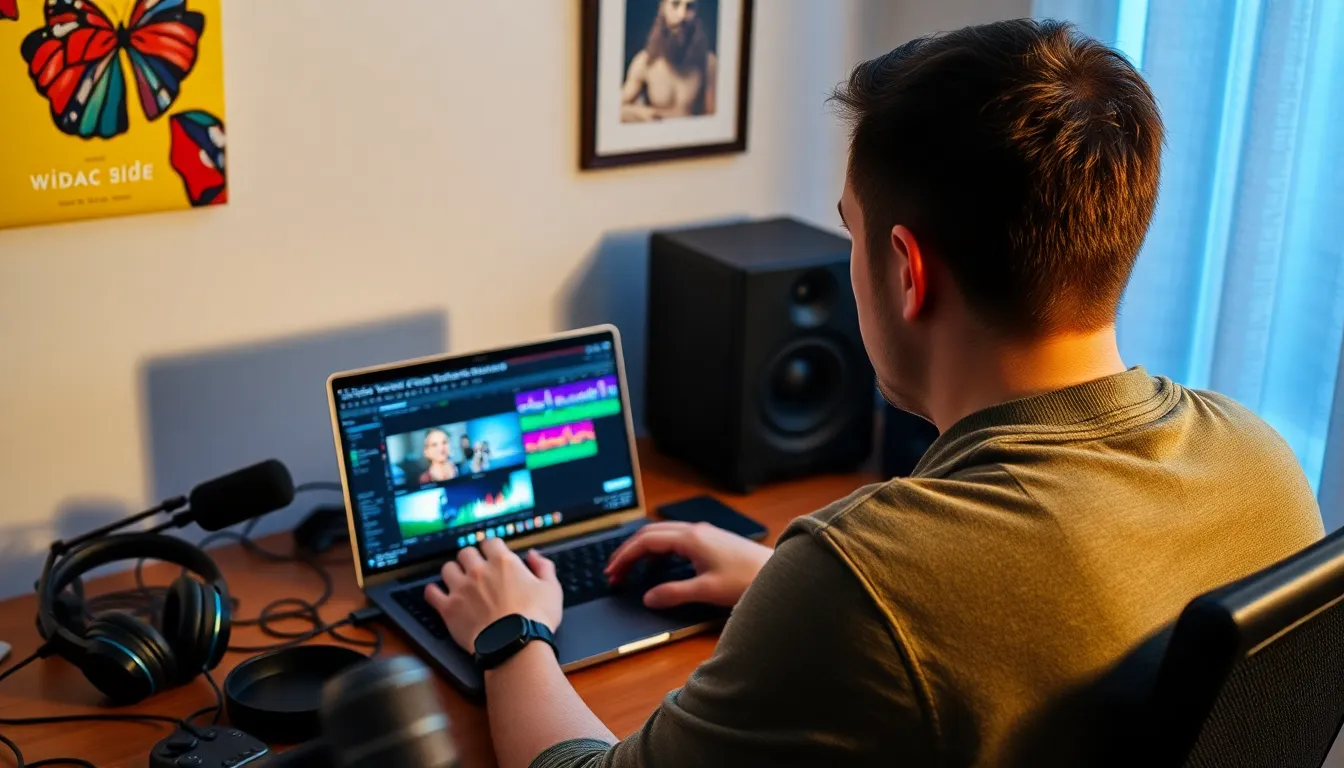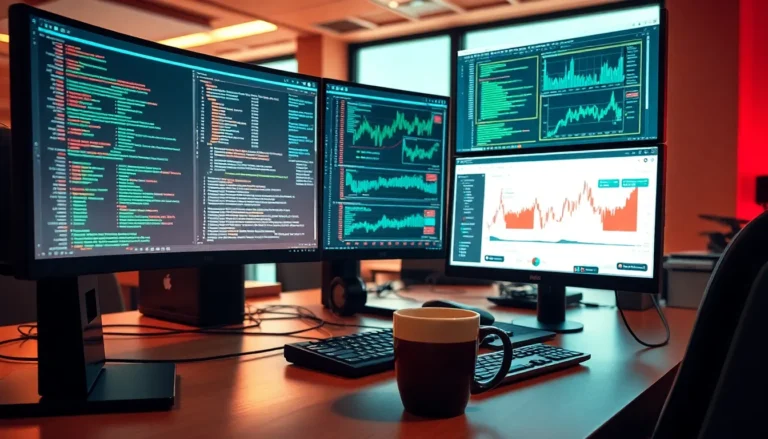In a world overflowing with content, standing out requires more than just hitting the record button. Editing video isn’t just about cutting out the bloopers—it’s about crafting a story that captivates, engages, and maybe even makes someone giggle. Whether you’re a budding filmmaker or just trying to make your cat’s antics go viral, mastering the art of video editing can turn your raw footage into a polished masterpiece.
Table of Contents
ToggleUnderstanding Video Editing
Video editing involves the process of manipulating and arranging video footage to create a finished product. This process plays a critical role in storytelling, enhancing the overall viewing experience.
What Is Video Editing?
Video editing refers to the selection, arrangement, and enhancement of video clips. It encompasses various techniques like trimming, cutting, and sequencing clips together. Additionally, video editors add elements like transitions, effects, and sound to clarify the narrative. They shape raw footage into a coherent story, allowing viewers to engage with the content effectively.
Importance of Video Editing
Video editing serves as a valuable tool for content creators. Effective video editing can elevate a simple recording into a compelling narrative that grabs attention. It retains viewer interest and communicates messages clearly by showcasing key moments through appropriate cuts and transitions. Mastery of editing techniques equips individuals to produce quality content, whether for personal videos or professional projects. Engaging videos increase the chances of reaching wider audiences, ultimately contributing to success in the crowded digital space.
Getting Started with Video Editing

Starting video editing requires the right tools and an understanding of fundamental techniques. Knowledge in these areas lays the groundwork for creating compelling narratives.
Choosing the Right Software
Selecting suitable video editing software is essential for any project. Several options exist, catering to varying skill levels and budgets. Free programs like DaVinci Resolve and Lightworks offer robust features for beginners. For those with more experience, Adobe Premiere Pro and Final Cut Pro X provide advanced capabilities. Each software has unique features suited for specific tasks, such as color grading or special effects. Researching the software’s learning curve and available tutorials can enhance the editing experience.
Basic Editing Tools and Features
Familiarity with basic editing tools enhances productivity. Essential functions include trimming clips to remove unwanted footage, cutting segments to combine multiple clips effectively, and sequencing to create a cohesive flow. Adding transitions helps smooth visual changes between clips. Utilizing effects and filters can improve the overall aesthetic of the video. Sound editing tools enable users to adjust audio levels or add background music. Each of these features contributes significantly to storytelling and audience engagement.
The Video Editing Process
The video editing process involves several key steps to create a polished final product.
Importing Your Footage
Importing footage marks one of the essential initial steps. Use video editing software to upload all recorded clips to the project library. Common formats include MP4, AVI, and MOV, which many programs support. Ensuring compatibility with the chosen software simplifies the editing process. Organizing files during import helps in locating specific clips quickly, improving efficiency as you move forward.
Organizing Your Clips
Organizing clips enhances workflow and productivity. Create folders for different scenes, angles, or events, allowing easy access during editing. Labeling clips descriptively aids in identifying content without sifting through all footage. Utilize tags or color codes to categorize clips by importance or quality. A well-organized library helps streamline the editing process, reducing time spent searching for specific videos.
Basic Editing Techniques
Basic editing techniques form the foundation of effective video production. Trimming removes unnecessary footage, ensuring that the main story is concise and engaging. Cutting allows seamless transitions between shots, maintaining viewer interest. Sequencing arranges clips in a coherent order, enhancing narrative flow. Adding transitions and effects can elevate viewing experience further, while sound editing ensures that audio aligns with video content effectively. By mastering these basic techniques, editors can significantly improve their projects’ overall quality.
Adding Elements to Your Video
Enhancing your video with various elements boosts engagement and storytelling. Two key areas to focus on are sound and visual transitions.
Incorporating Music and Sound Effects
Music sets the tone and mood for any video. Choosing appropriate tracks enhances the emotional impact of scenes. Sound effects add realism and can highlight specific actions or moments, making them more memorable. When selecting music, consider licensing options to avoid copyright issues. Platforms like Epidemic Sound or Artlist offer a range of royalty-free options. Sound bites should sync with video actions for maximum effect. Ensure that audio levels are balanced, so dialogue remains clear and unobscured.
Using Transitions and Effects
Transitions connect different clips and manage the flow of the video. Utilizing fades, wipes, or cuts can create visual interest and maintain viewer attention. Employing effects can bring unique elements to a project, such as color grading for a distinct look or slow motion for dramatic emphasis. Avoid overusing effects, as they can distract from the main content. Each transition and effect should reinforce the storytelling rather than detract from it. Familiarize yourself with the software’s features to customize transitions that enhance visual continuity.
Finalizing Your Video
Finalizing a video involves crucial steps like exporting and sharing, ensuring a polished presentation. Following these processes guarantees the content reaches the intended audience effectively.
Exporting Your Project
Exporting the final project requires selecting the appropriate format based on the intended platform. MP4 serves as a universally compatible option. Users should adjust settings such as resolution and bitrate for optimal quality. Choosing the right codec is also essential to avoid loss in clarity. Before starting the export, it’s advised to review the project, checking for any last-minute adjustments. Saving a backup during the export process provides an added layer of security.
Tips for Sharing and Publishing
Sharing the final video effectively involves understanding the target audience and selecting the right platforms. Social media sites like YouTube, Instagram, and Facebook offer vast reach. Customizing video settings for each platform, including thumbnail design and captions, enhances viewer engagement. Crafting engaging titles and descriptions contributes to visibility and helps attract viewers. Consistently promoting the video across various channels can maximize exposure. Monitoring feedback and analytics allows for adjustments in future projects, fostering continuous improvement.
Mastering video editing is a vital skill for anyone looking to create impactful content. By understanding the tools and techniques discussed, individuals can transform their raw footage into engaging stories that resonate with audiences.
Whether it’s for personal enjoyment or professional endeavors, effective editing enhances the viewing experience and communicates messages clearly.
As creators continue to explore their unique styles and narratives, the right approach to video editing can significantly elevate their projects. Embracing these principles will not only improve video quality but also expand reach in an ever-evolving digital landscape.



